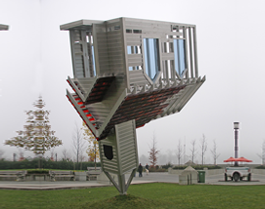Dennis Oppenheim was a leading figure in the development of conceptual art, land art, and other avant-garde practices including performance and body art. But it is, perhaps, his public artwork that brought him the widest recognition: charming and, sometimes outraging his audiences.
For almost 30 years, Oppenheim worked on and completed over 30 public art commissions. Even though his works are engaging and whimsical, using a wide range of innovative materials and structures, they occasionally caused controversy.
It took the artist almost 3 years to find a city to host his playful sculpture Device to Root Out Evil. Commissioned by Stanford University, Oppenheim’s large sculpture of a church upside down, its steeple buried in the ground, was deemed inappropriate by the university’s president.
Even New York City passed on it. The director of City’s public art fund rejected the artist’s offer to display the glass-and-aluminum church on Church Street, citing worries that religious leaders would be offended.
It finally found a home in Vancouver in 2005. But, ultimately, the sculpture proved too controversial even for that city and was removed in 2008. Eventually it found a home in Calgary.
This is what Oppenheim said about the work,
“In sculpture, economy of gesture is often the mark of a successful work. In Device to Root out Evil, the simple inversion of a building (a church) is enough to radically alter the content of this object, and propel it into the pantheon reserved for high art. The steeple, usually piercing the sky in its lunge toward heaven, is now at ground level, pursuing with vigor, the demons of the deep. The church becomes dynamic by cantilevering this meeting place into mid air, thus projecting all occupants into a spacial no mans land where equilibrium is exchanged for the dynamics of pursuit.”
For more information on the artist, visit his website.


